A Reconstruction of Irrigated Cropland Extent in China from 2000 to 2019 Using the Synergy of Statistics and Satellite-Based Datasets
Abstract
1. Introduction
2. Data and Methods
2.1. Study Area
2.2. Input Data
2.2.1. Cropland Extent Data
2.2.2. Statistical Area of Irrigated Cropland
2.2.3. Existing Irrigation Maps
2.2.4. Remote Sensing Data on Irrigated Cropping Systems
2.3. Methods
2.3.1. Synergy Irrigation Mapping
2.3.2. Validation of Resultant Maps
3. Results
3.1. Accuracy Assessment of the Rebuilt Dataset
3.2. Spatial Pattern Comparison among the Rebuilt Dataset with Other Existing Datasets
3.3. Tracking Irrigated Cropland Changes in China
4. Discussion
5. Conclusions
Author Contributions
Funding
Data Availability Statement
Acknowledgments
Conflicts of Interest
Appendix A
Appendix B
| Province Name | Statistics | Irrimap-Syn | CCI-LC | HYDE | ||||
|---|---|---|---|---|---|---|---|---|
| Average Area | Area Changes | Area Differences with Statistics | Area Changes | Area Differences with Statistics | Area Changes | Area Differences with Statistics | Area Changes | |
| Beijing | 247 | −225 | 191 | −238 | −170 | −1 | 63 | 35 |
| Tianjin | 359 | −62 | 352 | −25 | −233 | −1 | 92 | 73 |
| Hebei | 4753 | −39 | 4300 | −160 | −3627 | −19 | −90 | 647 |
| Shanxi | 1309 | 454 | 1185 | 314 | −993 | −6 | −58 | 362 |
| Nei Mongol | 2893 | 830 | 2577 | 449 | −849 | 212 | −1306 | 533 |
| Liaoning | 1629 | 205 | 1525 | 230 | −265 | −65 | −384 | 947 |
| Jilin | 1675 | 607 | 1669 | 589 | 339 | 159 | −242 | 1759 |
| Heilongjiang | 3937 | 4151 | 3892 | 4236 | −2268 | 36 | −1841 | 2673 |
| Shanghai | 234 | −95 | 208 | −95 | 186 | −94 | 41 | 12 |
| Jiangsu | 3989 | 368 | 4055 | 266 | 3220 | −412 | 749 | 126 |
| Zhejiang | 1490 | 28 | 1368 | −44 | 379 | −221 | −115 | 437 |
| Anhui | 3786 | 1405 | 3647 | 1374 | 4182 | −151 | 427 | 416 |
| Fujian | 1045 | 204 | 908 | 28 | −398 | −73 | −630 | 340 |
| Jiangxi | 1961 | 171 | 1892 | 137 | 463 | −55 | 237 | 305 |
| Shandong | 5288 | 469 | 4791 | 484 | −2282 | −118 | 555 | 874 |
| Henan | 5076 | 614 | 4922 | 669 | 1968 | −273 | 485 | 560 |
| Hubei | 2487 | 937 | 2199 | 350 | 3541 | −106 | 276 | 589 |
| Hunan | 2892 | 516 | 2819 | 410 | 211 | −73 | −92 | 62 |
| Guangdong | 1804 | 400 | 1835 | −193 | 624 | −192 | −453 | 639 |
| Guangxi | 1599 | 266 | 1514 | 3 | 638 | −90 | −177 | 761 |
| Hainan | 238 | 126 | 177 | 21 | 11 | −18 | −81 | 177 |
| Chongqing | 664 | 73 | 626 | 211 | −443 | −24 | 122 | 591 |
| Sichuan | 2682 | 608 | 2428 | 581 | −1179 | −82 | −98 | 1165 |
| Guizhou | 928 | 506 | 1128 | 965 | −752 | −16 | −509 | 498 |
| Yunnan | 1666 | 563 | 1556 | 377 | −839 | −29 | −922 | 588 |
| Xizang | 222 | 138 | 123 | −41 | 39 | 9 | −200 | 39 |
| Shaanxi | 1393 | 11 | 1247 | 125 | −83 | −43 | −118 | 249 |
| Gansu | 1209 | 377 | 1046 | 163 | −392 | 45 | −494 | 616 |
| Qinghai | 211 | 5 | 169 | −20 | 1 | 8 | −123 | 95 |
| Ningxia Hui | 490 | 150 | 447 | 49 | −150 | 3 | −170 | 130 |
| Xinjiang Uygur | 4337 | 2151 | 3352 | 1797 | 6657 | 1251 | −1740 | 1258 |
| Sum | 62,494 | 15,912 | 58,151 | 13,010 | 7537 | −439 | −6797 | 17,553 |
References
- Yu, Q.; You, L.; Wood-Sichra, U.; Ru, Y.; Joglekar, A.K.B.; Fritz, S.; Xiong, W.; Lu, M.; Wu, W.; Yang, P. A cultivated planet in 2010—Part 2: The global gridded agricultural-production maps. Earth Syst. Sci. Data 2020, 12, 3545–3572. [Google Scholar] [CrossRef]
- Godfray, H.C.J.; Beddington, J.R.; Crute, I.R.; Haddad, L.; Lawrence, D.; Muir, J.F.; Pretty, J.; Robinson, S.; Thomas, S.M.; Toulmin, C. Food Security: The Challenge of Feeding 9 Billion People. Science 2010, 327, 812–818. [Google Scholar] [CrossRef]
- Gibbs, H.K.; Ruesch, A.S.; Achard, F.; Clayton, M.K.; Holmgren, P.; Ramankutty, N.; Foley, J.A. Tropical forests were the primary sources of new agricultural land in the 1980s and 1990s. Proc. Natl. Acad. Sci. USA 2010, 107, 16732–16737. [Google Scholar] [CrossRef]
- Foley, J.A.; Defries, R.; Asner, G.P.; Barford, C.; Bonan, G.; Carpenter, S.R.; Chapin, F.S.; Coe, M.T.; Daily, G.C.; Gibbs, H.K.; et al. Global consequences of land use. Science 2005, 309, 570–574. [Google Scholar] [CrossRef]
- Ramankutty, N.; Evan, A.T.; Monfreda, C.; Foley, J.A. Farming the planet: 1. Geographic distribution of global agricultural lands in the year 2000. Glob. Biogeochem. Cycles 2008, 22. [Google Scholar] [CrossRef]
- Mueller, N.D.; Gerber, J.S.; Johnston, M.; Ray, D.K.; Ramankutty, N.; Foley, J.A. Closing yield gaps through nutrient and water management. Nature 2012, 490, 254–257. [Google Scholar] [CrossRef]
- Rosa, L.; Rulli, M.C.; Davis, K.F.; Chiarelli, D.D.; Passera, C.; D’Odorico, P. Closing the yield gap while ensuring water sustainability. Environ. Res. Lett. 2018, 13, 104002. [Google Scholar] [CrossRef]
- Brown, J.F.; Pervez, M.S. Merging remote sensing data and national agricultural statistics to model change in irrigated agriculture. Agric. Syst. 2014, 127, 28–40. [Google Scholar] [CrossRef]
- Zhang, J.; Guan, K.; Peng, B.; Pan, M.; Zhou, W.; Jiang, C.; Kimm, H.; Franz, T.E.; Grant, R.F.; Yang, Y.; et al. Sustainable irrigation based on co-regulation of soil water supply and atmospheric evaporative demand. Nat. Commun. 2021, 12, 5549. [Google Scholar] [CrossRef]
- Wang, X.; Muller, C.; Elliot, J.; Mueller, N.D.; Ciais, P.; Jagermeyr, J.; Gerber, J.; Dumas, P.; Wang, C.; Yang, H.; et al. Global irrigation contribution to wheat and maize yield. Nat. Commun. 2021, 12, 1235. [Google Scholar] [CrossRef]
- Wada, Y.; van Beek, L.P.H.; van Kempen, C.M.; Reckman, J.W.T.M.; Vasak, S.; Bierkens, M.F.P. Global depletion of groundwater resources. Geophys. Res. Lett. 2010, 37, 1–5. [Google Scholar] [CrossRef]
- Droppers, B.; Supit, I.; van Vliet, M.T.H.; Ludwig, F. Worldwide water constraints on attainable irrigated production for major crops. Environ. Res. Lett. 2021, 16, 055016. [Google Scholar] [CrossRef]
- Siebert, S.; Döll, P. Quantifying blue and green virtual water contents in global crop production as well as potential production losses without irrigation. J. Hydrol. 2010, 384, 198–217. [Google Scholar] [CrossRef]
- Huang, Q.; Rozelle, S.; Lohmar, B.; Huang, J.; Wang, J. Irrigation, agricultural performance and poverty reduction in China. Food Policy 2006, 31, 30–52. [Google Scholar] [CrossRef]
- Döll, P.; Müller Schmied, H.; Schuh, C.; Portmann, F.T.; Eicker, A. Global-scale assessment of groundwater depletion and related groundwater abstractions: Combining hydrological modeling with information from well observations and GRACE satellites. Water Resour. Res. 2014, 50, 5698–5720. [Google Scholar] [CrossRef]
- Shiklomanov, I.A. Appraisal and Assessment of World Water Resources. Water Int. 2000, 25, 11–32. [Google Scholar] [CrossRef]
- Döll, P.; Siebert, S. Global modeling of irrigation water requirements. Water Resour. Res. 2002, 38, 8-1–8-10. [Google Scholar] [CrossRef]
- Scanlon, B.R.; Jolly, I.; Sophocleous, M.; Zhang, L. Global impacts of conversions from natural to agricultural ecosystems on water resources: Quantity versus quality. Water Resour. Res. 2007, 43, 215–222. [Google Scholar] [CrossRef]
- Meier, J.; Zabel, F.; Mauser, W. A global approach to estimate irrigated areas—A comparison between different data and statistics. Hydrol. Earth Syst. Sci. 2018, 22, 1119–1133. [Google Scholar] [CrossRef]
- Huang, Q.; Wang, J.; Li, Y. Do water saving technologies save water? Empirical evidence from North China. J. Environ. Econ. Manag. 2017, 82, 1–16. [Google Scholar] [CrossRef]
- Tilman, D.; Balzer, C.; Hill, J.; Befort, B.L. Global food demand and the sustainable intensification of agriculture. Proc. Natl. Acad. Sci. USA 2011, 108, 20260–20264. [Google Scholar] [CrossRef]
- Foley, J.A.; Ramankutty, N.; Brauman, K.A.; Cassidy, E.S.; Gerber, J.S.; Johnston, M.; Mueller, N.D.; O’Connell, C.; Ray, D.K.; West, P.C.; et al. Solutions for a cultivated planet. Nature 2011, 478, 337–342. [Google Scholar] [CrossRef]
- Grafton, R.Q.; Williams, J.; Jiang, Q. Possible pathways and tensions in the food and water nexus. Earth’s Future 2017, 5, 449–462. [Google Scholar] [CrossRef]
- Nagaraj, D.; Proust, E.; Todeschini, A.; Rulli, M.C.; D’Odorico, P. A new dataset of global irrigation areas from 2001 to 2015. Adv. Water Resour. 2021, 152, 103910. [Google Scholar] [CrossRef]
- Dinar, A.; Tieu, A.; Huynh, H. Water scarcity impacts on global food production. Glob. Food Secur. 2019, 23, 212–226. [Google Scholar] [CrossRef]
- Han, Z. Strategy on high quality development of large and medium irrigation districts in the new period. China Water Resour. 2021, 17, 15–17+14. [Google Scholar] [CrossRef]
- Piao, S.; Ciais, P.; Huang, Y.; Shen, Z.; Peng, S.; Li, J.; Zhou, L.; Liu, H.; Ma, Y.; Ding, Y.; et al. The impacts of climate change on water resources and agriculture in China. Nature 2010, 467, 43–51. [Google Scholar] [CrossRef]
- Fischer, G.; Chen, Y.; Sun, L. The Balance of Cultivated Land in China during 1988–1995; International Institute for Applied Systems Analysis: Laxenburg, Austria, 1998. [Google Scholar]
- Wu, P.; Jin, J.; Zhao, X. Impact of climate change and irrigation technology advancement on agricultural water use in China. Clim. Change 2010, 100, 797–805. [Google Scholar] [CrossRef]
- Varis, O.; Vakkilainen, P. China’s 8 challenges to water resources management in the first quarter of the 21st Century. Geomorphology 2001, 41, 93–104. [Google Scholar] [CrossRef]
- Molle, F.; Mollinga, P.P.; Wester, P. Hydraulic Bureaucracies and the Hydraulic Mission: Flows of water, Flows of power. Water Altern. 2009, 2, 328–349. [Google Scholar]
- Zhu, X.; Zhu, W.; Zhang, J.; Pan, Y. Mapping Irrigated Areas in China From Remote Sensing and Statistical Data. IEEE J. Sel. Top. Appl. Earth Obs. Remote Sens. 2014, 7, 4490–4504. [Google Scholar] [CrossRef]
- Liu, J.; Zang, C.; Tian, S.; Liu, J.; Yang, H.; Jia, S.; You, L.; Liu, B.; Zhang, M. Water conservancy projects in China: Achievements, challenges and way forward. Glob. Environ. Chang. 2013, 23, 633–643. [Google Scholar] [CrossRef]
- Pervez, M.S.; Brown, J.F. Mapping Irrigated Lands at 250-m Scale by Merging MODIS Data and National Agricultural Statistics. Remote Sens. 2010, 2, 2388–2412. [Google Scholar] [CrossRef]
- Ozdogan, M.; Yang, Y.; Allez, G.; Cervantes, C. Remote Sensing of Irrigated Agriculture: Opportunities and Challenges. Remote Sens. 2010, 2, 2274–2304. [Google Scholar] [CrossRef]
- Zhang, C.; Dong, J.; Zuo, L.; Ge, Q. Tracking spatiotemporal dynamics of irrigated croplands in China from 2000 to 2019 through the synergy of remote sensing, statistics, and historical irrigation datasets. Agric. Water Manag. 2022, 263, 107458. [Google Scholar] [CrossRef]
- Xie, Y.; Lark, T.J.; Brown, J.F.; Gibbs, H.K. Mapping irrigated cropland extent across the conterminous United States at 30 m resolution using a semi-automatic training approach on Google Earth Engine. ISPRS J. Photogramm. Remote Sens. 2019, 155, 136–149. [Google Scholar] [CrossRef]
- Liang, S.; Wang, J. (Eds.) Remote sensing application in agriculture. In Advanced Remote Sensing, 2nd ed.; Academic Press: Cambridge, MA, USA, 2020; Chapter 24; pp. 871–914. [Google Scholar] [CrossRef]
- Yang, H.; Zhang, X.; Zehnder, A.J.B. Water scarcity, pricing mechanism and institutional reform in northern China irrigated agriculture. Agric. Water Manag. 2003, 61, 143–161. [Google Scholar] [CrossRef]
- Ambika, A.K.; Wardlow, B.; Mishra, V. Remotely sensed high resolution irrigated area mapping in India for 2000 to 2015. Sci. Data 2016, 3, 160118. [Google Scholar] [CrossRef]
- Lu, M.; Wu, W.; You, L.; See, L.; Fritz, S.; Yu, Q.; Wei, Y.; Chen, D.; Yang, P.; Xue, B. A cultivated planet in 2010—Part 1: The global synergy cropland map. Earth Syst. Sci. Data 2020, 12, 1913–1928. [Google Scholar] [CrossRef]
- Winkler, K.; Fuchs, R.; Rounsevell, M.; Herold, M. Global land use changes are four times greater than previously estimated. Nat. Commun. 2021, 12, 2501. [Google Scholar] [CrossRef]
- Frolking, S.; Qiu, J.; Boles, S.; Xiao, X.; Liu, J.; Zhuang, Y.; Li, C.; Qin, X. Combining remote sensing and ground census data to develop new maps of the distribution of rice agriculture in China. Glob. Biogeochem. Cycles 2002, 16, 38-1–38-10. [Google Scholar] [CrossRef]
- Salmon, J.M.; Friedl, M.A.; Frolking, S.; Wisser, D.; Douglas, E.M. Global rain-fed, irrigated, and paddy croplands: A new high resolution map derived from remote sensing, crop inventories and climate data. Int. J. Appl. Earth Obs. Geoinf. 2015, 38, 321–334. [Google Scholar] [CrossRef]
- Thenkabail, P.; Teluguntla, P.; Xiong, J.; Oliphant, A.; Massey, R. NASA MEaSUREs Global Food Security Support Analysis Data (GFSAD) Crop Mask 2010 Global 1 km V001; NASA EOSDIS Land Processes DAAC: Sioux Falls, SD, USA, 2016. [CrossRef]
- Xiang, K.; Yuan, W.; Wang, L.; Deng, Y. An LSWI-Based Method for Mapping Irrigated Areas in China Using Moderate-Resolution Satellite Data. Remote Sens. 2020, 12, 4181. [Google Scholar] [CrossRef]
- ESA. Land Cover CCI Product User Guide Version 2; ESA: Paris, France, 2017. [Google Scholar]
- Klein Goldewijk, K.; Beusen, A.; Doelman, J.; Stehfest, E. Anthropogenic land use estimates for the Holocene—HYDE 3.2. Earth Syst. Sci. Data 2017, 9, 927–953. [Google Scholar] [CrossRef]
- Deines, J.M.; Kendall, A.D.; Crowley, M.A.; Rapp, J.; Cardille, J.A.; Hyndman, D.W. Mapping three decades of annual irrigation across the US High Plains Aquifer using Landsat and Google Earth Engine. Remote Sens. Environ. 2019, 233, 111400. [Google Scholar] [CrossRef]
- Xu, T.; Deines, J.; Kendall, A.; Basso, B.; Hyndman, D. Addressing Challenges for Mapping Irrigated Fields in Subhumid Temperate Regions by Integrating Remote Sensing and Hydroclimatic Data. Remote Sens. 2019, 11, 370. [Google Scholar] [CrossRef]
- Frolking, S.; Xiao, X.; Zhuang, Y.; Salas, W.; Li, C. Agricultural land-use in China a comparison of area estimates from ground-based census and satellite-borne remote sensing. Glob. Ecol. Biogeogr. 1999, 8, 407–416. [Google Scholar] [CrossRef]
- Fritz, S.; See, L.; McCallum, I.; You, L.; Bun, A.; Moltchanova, E.; Duerauer, M.; Albrecht, F.; Schill, C.; Perger, C.; et al. Mapping global cropland and field size. Glob. Chang. Biol. 2015, 21, 1980–1992. [Google Scholar] [CrossRef]
- Lu, M.; Wu, W.; You, L.; Chen, D.; Zhang, L.; Yang, P.; Tang, H. A Synergy Cropland of China by Fusing Multiple Existing Maps and Statistics. Sensors 2017, 17, 1613. [Google Scholar] [CrossRef]
- Siebert, S.; Kummu, M.; Porkka, M.; Döll, P.; Ramankutty, N.; Scanlon, B.R. A global data set of the extent of irrigated land from 1900 to 2005. Hydrol. Earth Syst. Sci. 2015, 19, 1521–1545. [Google Scholar] [CrossRef]
- U.S. Department of Agriculture. Summary Report: 2007 National Resources Inventory; Natural Resources Conservation Service: Washington, DC, USA; Center for Survey Statistics and Methodology, I.S.U.: Ames, IA, USA, 2009.
- Winkler, K.; Fuchs, R.; Rounsevell, M.D.A.; Herold, M. HILDA+ Global Land Use Change between 1960 and 2019; PANGAEA: Minneapolis, MN, USA, 2020. [Google Scholar] [CrossRef]
- Liu, J.; Kuang, W.; Zhang, Z.; Xu, X.; Qin, Y.; Ning, J.; Zhou, W.; Zhang, S.; Li, R.; Yan, C.; et al. Spatiotemporal characteristics, patterns, and causes of land-use changes in China since the late 1980s. J. Geogr. Sci. 2014, 24, 195–210. [Google Scholar] [CrossRef]
- Zhang, X.; Liu, L.; Chen, X.; Gao, Y.; Xie, S.; Mi, J. GLC_FCS30: Global land-cover product with fine classification system at 30 m using time-series Landsat imagery. Earth Syst. Sci. Data 2021, 13, 2753–2776. [Google Scholar] [CrossRef]
- Siddiqui, S.; Cai, X.; Chandrasekharan, K. Irrigated Area Map Asia and Africa; International Water Management Institute (IWMI): Colombo, Sri Lanka, 2016. [Google Scholar]
- Luo, Y.; Zhang, Z.; Chen, Y.; Li, Z.; Tao, F. ChinaCropPhen1km: A high-resolution crop phenological dataset for three staple crops in China during 2000–2015 based on leaf area index (LAI) products. Earth Syst. Sci. Data 2020, 12, 197–214. [Google Scholar] [CrossRef]
- Zhang, G.; Xiao, X.; Biradar, C.M.; Dong, J.; Qin, Y.; Menarguez, M.A.; Zhou, Y.; Zhang, Y.; Jin, C.; Wang, J.; et al. Spatiotemporal patterns of paddy rice croplands in China and India from 2000 to 2015. Sci. Total Environ. 2017, 579, 82–92. [Google Scholar] [CrossRef]
- Han, J.; Zhang, Z.; Luo, Y.; Cao, J.; Zhang, L.; cheng, F.; Zhuang, H.; Zhang, J. APRA500: A 500 m Annual Paddy Rice Dataset for Monsoon Asia Using Multisource Remote Sensing Data; Zenodo: Geneva, Switzerland, 2021. [Google Scholar] [CrossRef]
- Han, J.; Zhang, Z.; Luo, Y.; Cao, J.; Zhang, L.; Zhuang, H.; Cheng, F.; Zhang, J.; Tao, F. Annual paddy rice planting area and cropping intensity datasets and their dynamics in the Asian monsoon region from 2000 to 2020. Agric. Syst. 2022, 200, 103437. [Google Scholar] [CrossRef]
- China Irrigation and Drainage Development Center. Water-Saving Efficient Irrigation System for Wheat. A Series of Lectures on Water-Saving and Efficient Irrigation System for Major Crops in China. 2008. Available online: http://www.jsgg.com.cn/CIDDC_SavingWaterClass_3/Index2_1.htm#2.1 (accessed on 30 June 2022).
- Luo, Y.; Zhang, Z.; Li, Z.; Chen, Y.; Zhang, L.; Cao, j.; Tao, F. Data for: Identifying the Spatiotemporal Changes of Annual Harvesting Areas for Three Staple Crops in China by Integrating Multi-Data Sources, 2nd ed.; Mendeley Data: New York, NY, USA, 2020. [Google Scholar] [CrossRef]
- Luo, Y.; Zhang, Z.; Li, Z.; Chen, Y.; Zhang, L.; Cao, J.; Tao, F. Identifying the spatiotemporal changes of annual harvesting areas for three staple crops in China by integrating multi-data sources. Environ. Res. Lett. 2020, 15, 074003. [Google Scholar] [CrossRef]
- Liu, L.; Xu, X.; Zhuang, D.; Chen, X.; Li, S. Changes in the potential multiple cropping system in response to climate change in China from 1960–2010. PLoS ONE 2013, 8, e80990. [Google Scholar] [CrossRef]
- Monfreda, C.; Ramankutty, N.; Foley, J.A. Farming the planet: 2. Geographic distribution of crop areas, yields, physiological types, and net primary production in the year 2000. Glob. Biogeochem. Cycles 2008, 22. [Google Scholar] [CrossRef]
- Han, J.; Zhang, Z.; Luo, Y.; Cao, J.; Zhang, L.; cheng, F.; Zhuang, H.; Zhang, J. ACIA500: A 500 m Annual Cropping Intensity Dataset for Monsoon Asia Based on MODIS Data; Zenodo: Geneva, Switzerland, 2021. [Google Scholar] [CrossRef]
- FAO; IIASA. Global Agro Ecological Zones Version 4 (GAEZv4). Available online: http://www.fao.org/gaez/ (accessed on 20 January 2022).
- Trambauer, P.; Maskey, S.; Werner, M.; Pappenberger, F.; van Beek, L.P.H.; Uhlenbrook, S. Identification and simulation of space–time variability of past hydrological drought events in the Limpopo River basin, southern Africa. Hydrol. Earth Syst. Sci. 2014, 18, 2925–2942. [Google Scholar] [CrossRef]
- Wambura, F.J. Sensitivity of the Evapotranspiration Deficit Index to Its Parameters and Different Temporal Scales. Hydrology 2021, 8, 26. [Google Scholar] [CrossRef]
- Wu, W.-b.; Yang, P.; Tang, H.-j.; Zhou, Q.-b.; Chen, Z.-x.; Shibasaki, R. Characterizing Spatial Patterns of Phenology in Cropland of China Based on Remotely Sensed Data. Agric. Sci. China 2010, 9, 101–112. [Google Scholar] [CrossRef]
- Sen, P.K. Estimates of the Regression Coefficient Based on Kendall’s Tau. J. Am. Stat. Assoc. 1968, 63, 1379–1389. [Google Scholar] [CrossRef]
- Kossack, C.F.; Kendall, M.G. Rank correlation methods. Am. Math. Mon. 1950, 57, 425–426. [Google Scholar] [CrossRef]
- Wang, J.; Li, Y.; Huang, J.; Yan, T.; Sun, T. Growing water scarcity, food security and goverment responses in China. Glob. Food Secur. 2017, 14, 9–17. [Google Scholar] [CrossRef]
- Xu, Z.; Chen, X.; Liu, J.; Zhang, Y.; Chau, S.; Bhattarai, N.; Wang, Y.; Li, Y.; Connor, T.; Li, Y. Impacts of irrigated agriculture on food-energy-water-CO2 nexus across metacoupled systems. Nat. Commun. 2020, 11, 5837. [Google Scholar] [CrossRef]
- General Plan for the Development of Water-Saving Reduction-Mining and High-Efficiency Water-Saving Irrigation in North China (2014–2018); China Irrigation and Drainage Development Center: Beijing, China, 2014; Available online: http://www.jsgg.com.cn/Index/Display.asp?NewsID=20209 (accessed on 30 June 2022).
- Action Plan for Comprehensive Control of Groundwater Overexploitation in North China. C.M.o.W. Resources. 2019. Available online: http://szy.mwr.gov.cn/zcfg/fg/202008/t20200819_1433310.html (accessed on 30 June 2022).
- The Ministry of Water Resources of the National Development and Reform Commission. National Action Plan for Water Conservation. 2019. Available online: http://www.gov.cn/gongbao/content/2019/content_5419221.htm (accessed on 30 June 2022).
- Xin, F.; Xiao, X.; Dong, J.; Zhang, G.; Zhang, Y.; Wu, X.; Li, X.; Zou, Z.; Ma, J.; Du, G.; et al. Large increases of paddy rice area, gross primary production, and grain production in Northeast China during 2000–2017. Sci. Total Environ. 2020, 711, 135183. [Google Scholar] [CrossRef]
- Liu, Y.; Wang, E.; Yang, X.; Wang, J. Contributions of climatic and crop varietal changes to crop production in the North China Plain, since 1980s. Glob. Chang. Biol. 2010, 16, 2287–2299. [Google Scholar] [CrossRef]
- Liu, Y.; Long, H.; Li, T.; Tu, S. Land use transitions and their effects on water environment in Huang-Huai-Hai Plain, China. Land Use Policy 2015, 47, 293–301. [Google Scholar] [CrossRef]
- Yu, Z.; Jin, X.; Miao, L.; Yang, X. A historical reconstruction of cropland in China from 1900 to 2016. Earth Syst. Sci. Data 2021, 13, 3203–3218. [Google Scholar] [CrossRef]
- Jeong, S.-J.; Ho, C.-H.; Piao, S.; Kim, J.; Ciais, P.; Lee, Y.-B.; Jhun, J.-G.; Park, S.K. Effects of double cropping on summer climate of the North China Plain and neighbouring regions. Nat. Clim. Chang. 2014, 4, 615–619. [Google Scholar] [CrossRef]
- Meng, Q.; Sun, Q.; Chen, X.; Cui, Z.; Yue, S.; Zhang, F.; Römheld, V. Alternative cropping systems for sustainable water and nitrogen use in the North China Plain. Agric. Ecosyst. Environ. 2012, 146, 93–102. [Google Scholar] [CrossRef]
- Wang, J.; Zhang, Y.; Gong, S.; Xu, D.; Juan, S.; Zhao, Y. Evapotranspiration, crop coefficient and yield for drip-irrigated winter wheat with straw mulching in North China Plain. Field Crops Res. 2018, 217, 218–228. [Google Scholar] [CrossRef]
- Feike, T.; Khor, L.Y.; Mamitimin, Y.; Ha, N.; Li, L.; Abdusalih, N.; Xiao, H.; Doluschitz, R. Determinants of cotton farmers’ irrigation water management in arid Northwestern China. Agric. Water Manag. 2017, 187, 1–10. [Google Scholar] [CrossRef]
- Li, S. (Ed.) Agricultural Statistics of China (1949–2019); Rural Social and Economic Survey Division, National Bureau of Statistics: Beijing, China, 2020. [Google Scholar]
- Zhang, T.; Zhai, Y.; Ma, X.; Shen, X.; Bai, Y.; Zhang, R.; Ji, C.; Hong, J. Towards environmental sustainability: Life cycle assessment-based water footprint analysis on China’s cotton production. J. Clean. Prod. 2021, 313, 127925. [Google Scholar] [CrossRef]
- A Brief Introduction to the Planning for the Extension of Supporting Facilities and Water-Saving Transformation in Large Irrigation Areas of China. 2003. Available online: http://www.jsgg.com.cn/Index/Display.asp?NewsID=1735 (accessed on 1 July 2022).
- Chen, M. Accelerating modernization of irrigation district for high quality development. China Water Resour. 2021, 17, 1–3. [Google Scholar] [CrossRef]
- Chen, Y.; Wang, K.; Lin, Y.; Shi, W.; Song, Y.; He, X. Balancing green and grain trade. Nat. Geosci. 2015, 8, 739–741. [Google Scholar] [CrossRef]
- Chen, C.; Park, T.; Wang, X.; Piao, S.; Xu, B.; Chaturvedi, R.K.; Fuchs, R.; Brovkin, V.; Ciais, P.; Fensholt, R.; et al. China and India lead in greening of the world through land-use management. Nat. Sustain. 2019, 2, 122–129. [Google Scholar] [CrossRef]
- Bryan, B.A.; Gao, L.; Ye, Y.; Sun, X.; Connor, J.D.; Crossman, N.D.; Stafford-Smith, M.; Wu, J.; He, C.; Yu, D.; et al. China’s response to a national land-system sustainability emergency. Nature 2018, 559, 193–204. [Google Scholar] [CrossRef]
- Suggestions on Strengthening the Protection of Cultivated Land and Improving Requisition-Compensation Balance. Available online: http://www.gov.cn/zhengce/2017-01/23/content_5162649.htm (accessed on 22 July 2022).
- Huang, L.; Xiao, T.; Zhao, Z.; Sun, C.; Liu, J.; Shao, Q.; Fan, J.; Wang, J. Effects of grassland restoration programs on ecosystems in arid and semiarid China. J. Environ. Manag. 2013, 117, 268–275. [Google Scholar] [CrossRef]
- Liu, Y.; Fang, F.; Li, Y. Key issues of land use in China and implications for policy making. Land Use Policy 2014, 40, 6–12. [Google Scholar] [CrossRef]
- Li, T.; Long, H.; Zhang, Y.; Tu, S.; Ge, D.; Li, Y.; Hu, B. Analysis of the spatial mismatch of grain production and farmland resources in China based on the potential crop rotation system. Land Use Policy 2017, 60, 26–36. [Google Scholar] [CrossRef]
- Zuo, L.; Zhang, Z.; Carlson, K.M.; MacDonald, G.K.; Brauman, K.A.; Liu, Y.; Zhang, W.; Zhang, H.; Wu, W.; Zhao, X.; et al. Progress towards sustainable intensification in China challenged by land-use change. Nat. Sustain. 2018, 1, 304–313. [Google Scholar] [CrossRef]
- He, C.; Liu, Z.; Xu, M.; Ma, Q.; Dou, Y. Urban expansion brought stress to food security in China: Evidence from decreased cropland net primary productivity. Sci. Total Environ. 2017, 576, 660–670. [Google Scholar] [CrossRef] [PubMed]
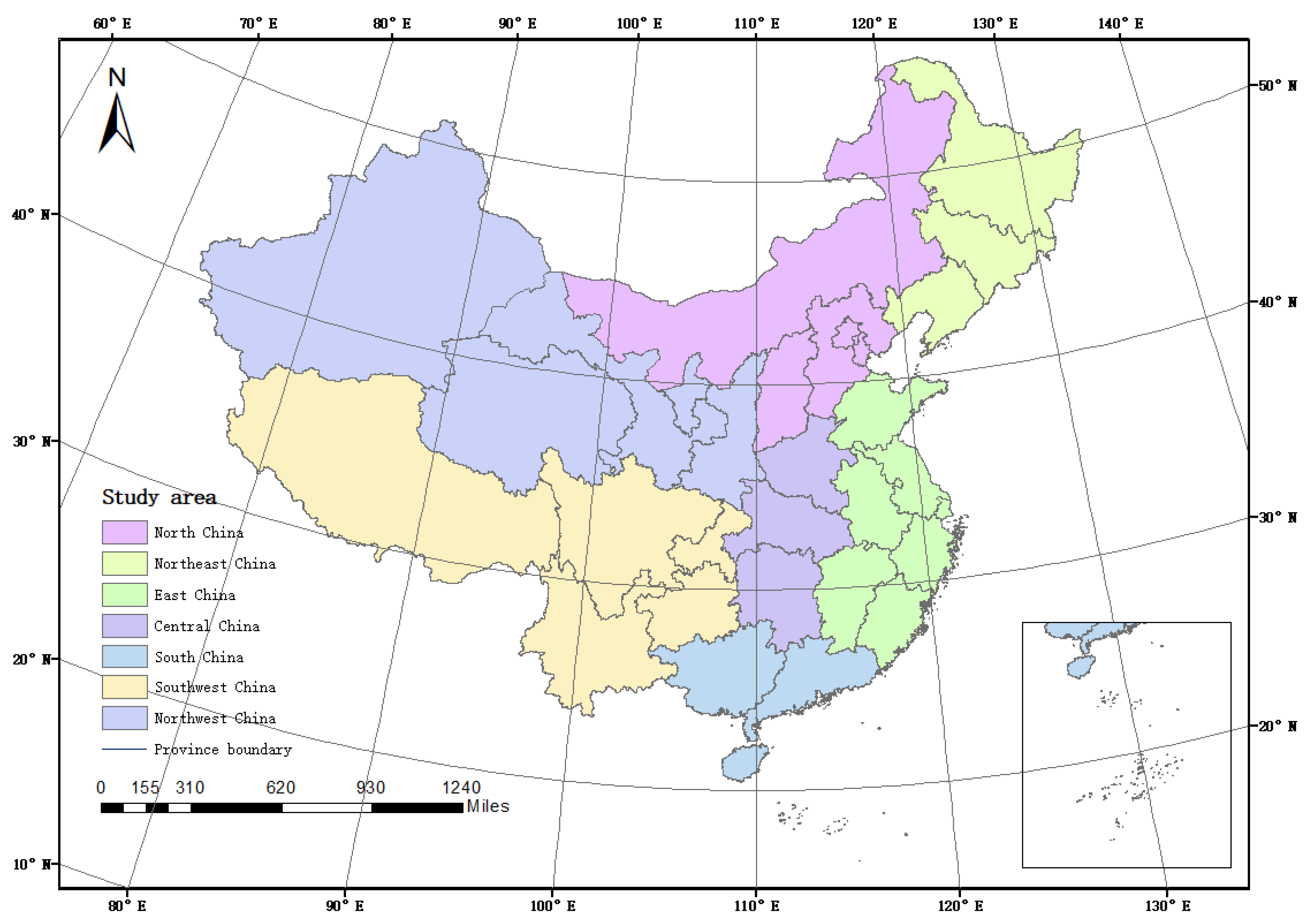

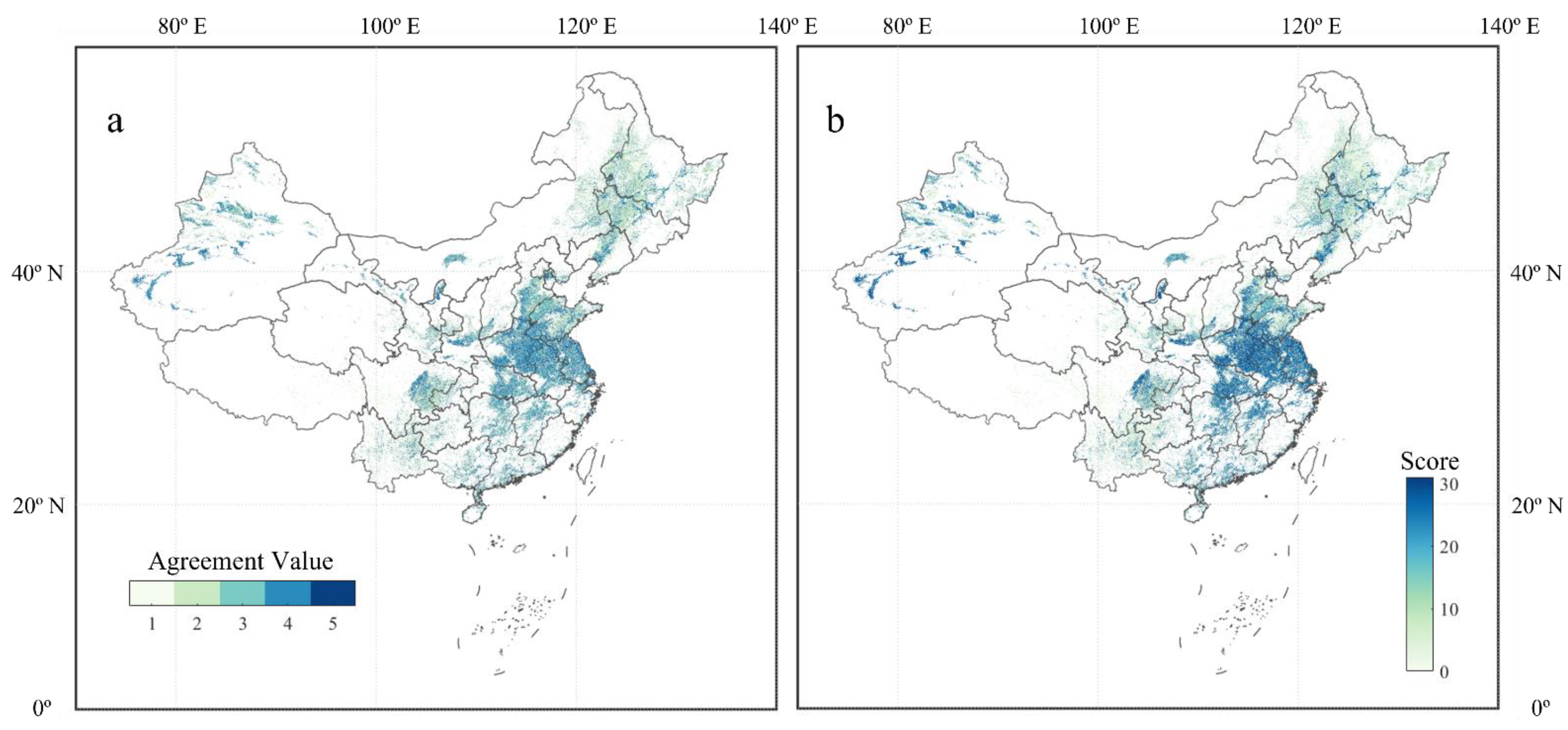
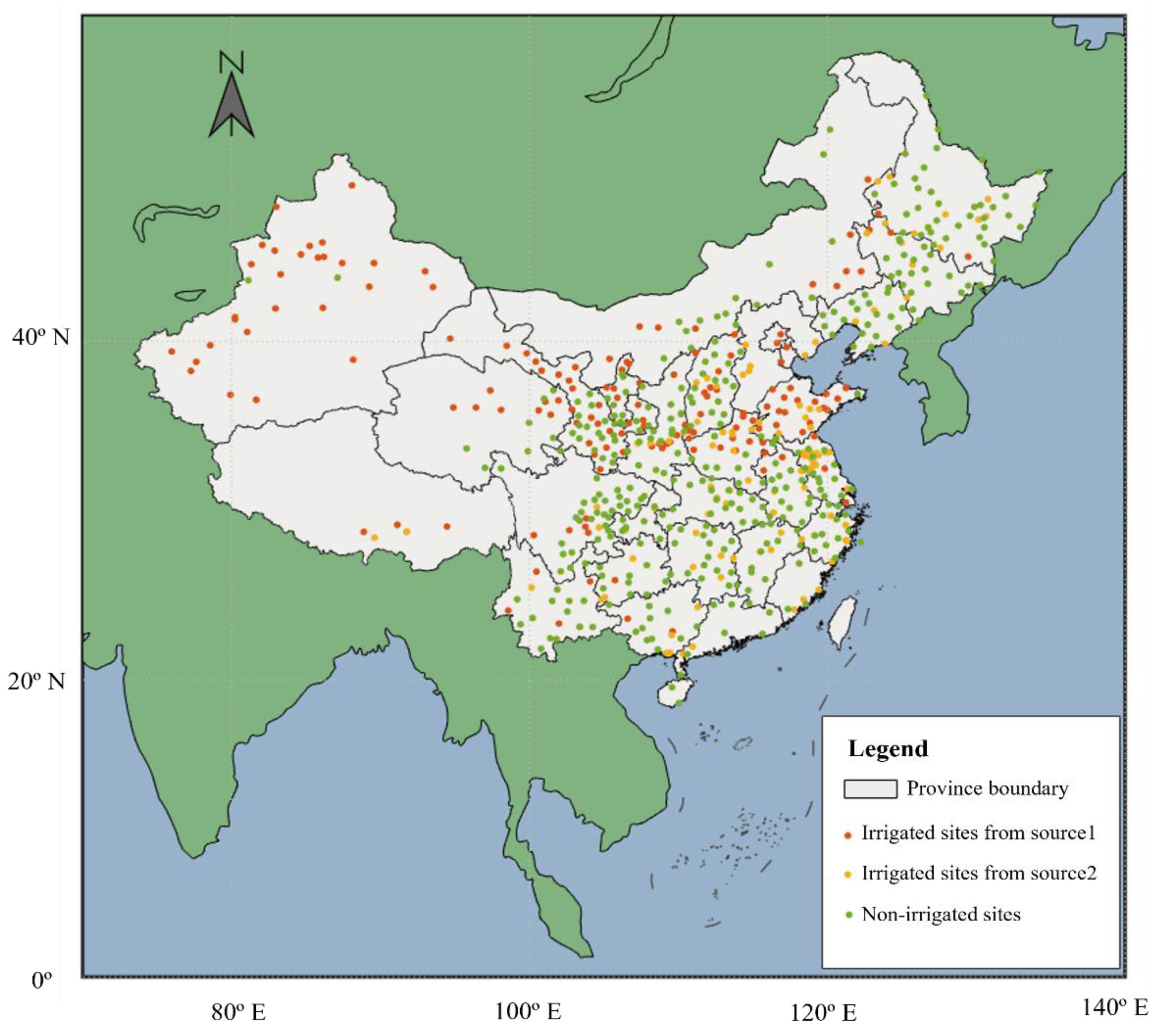


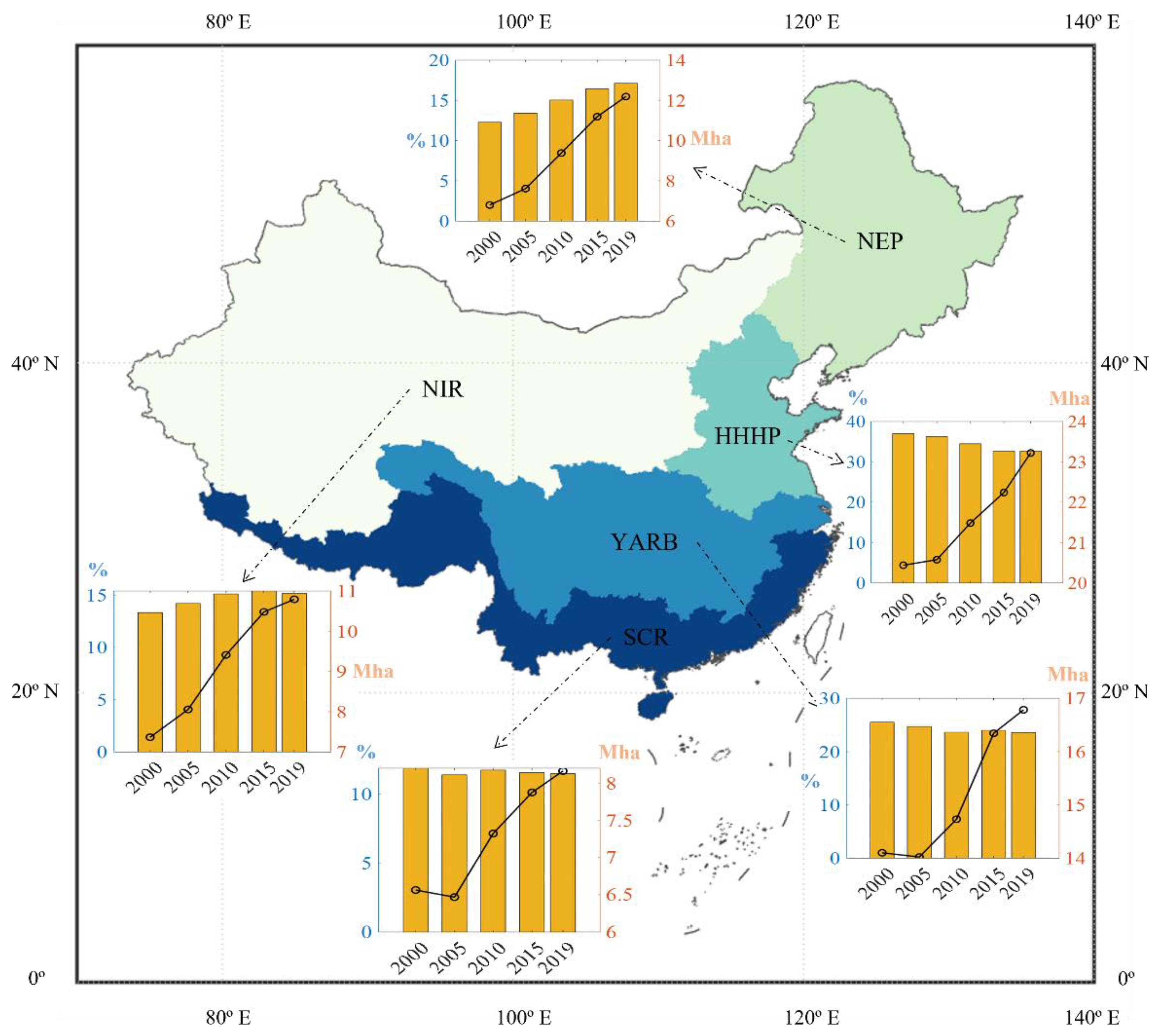
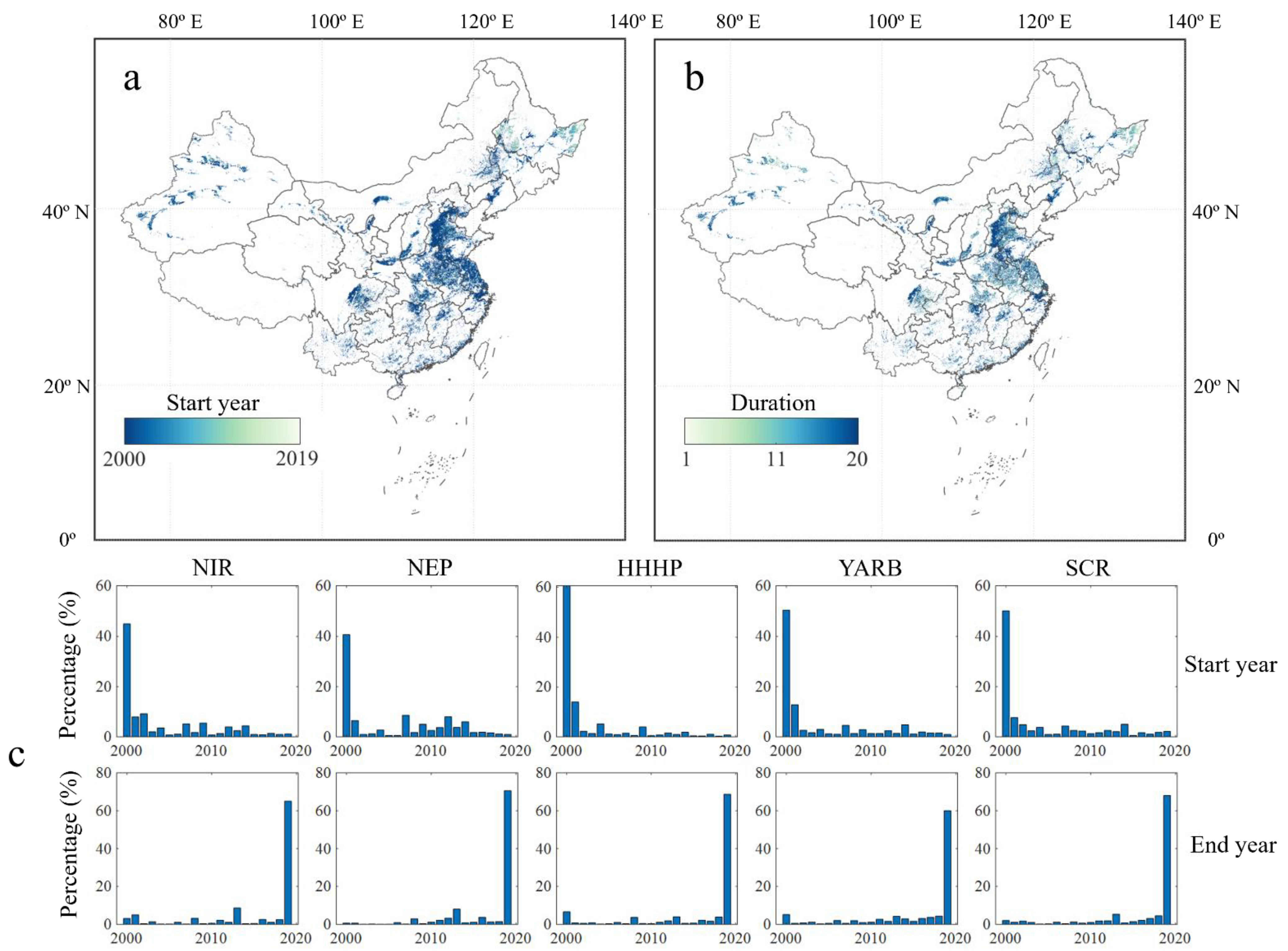
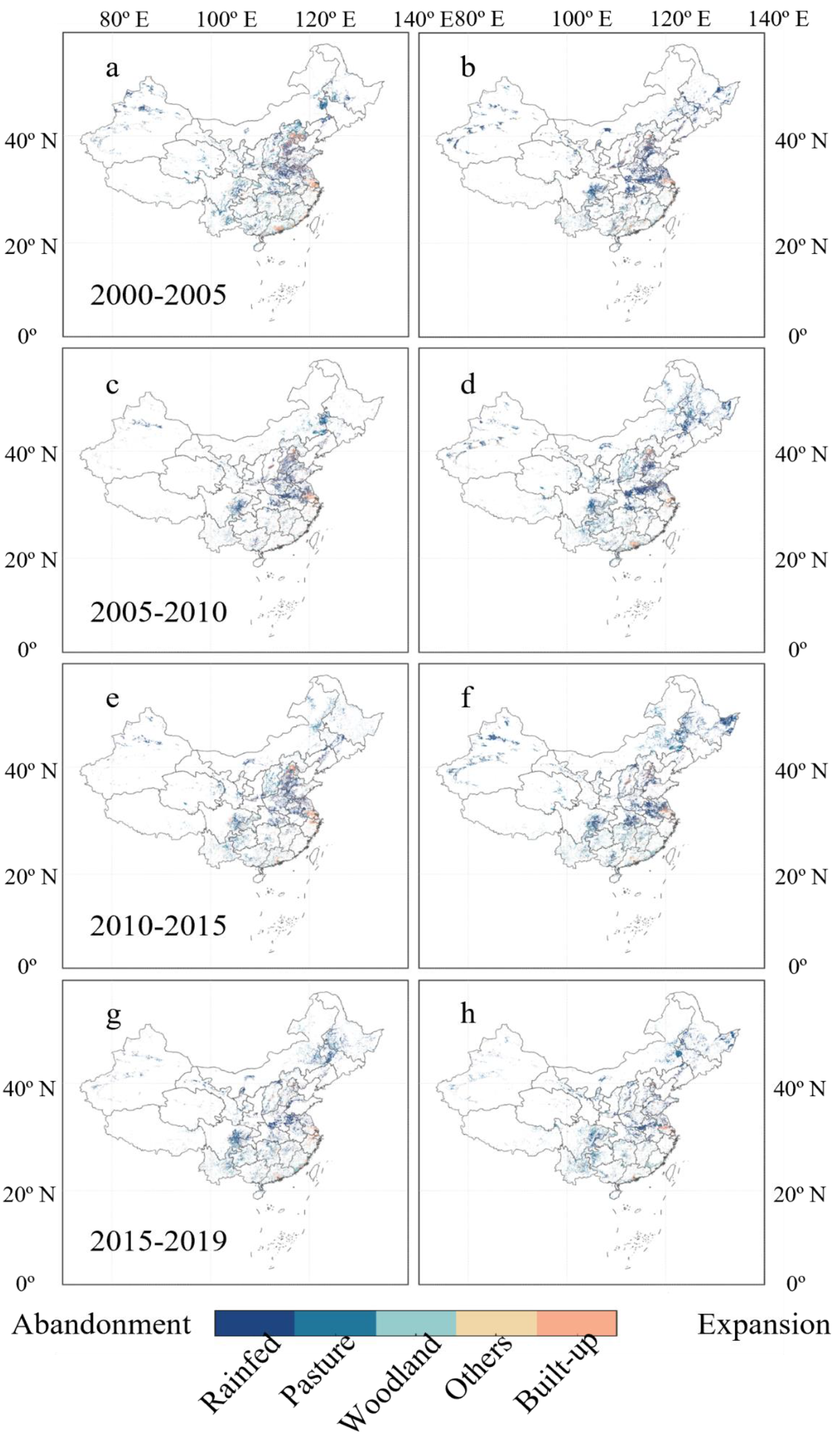
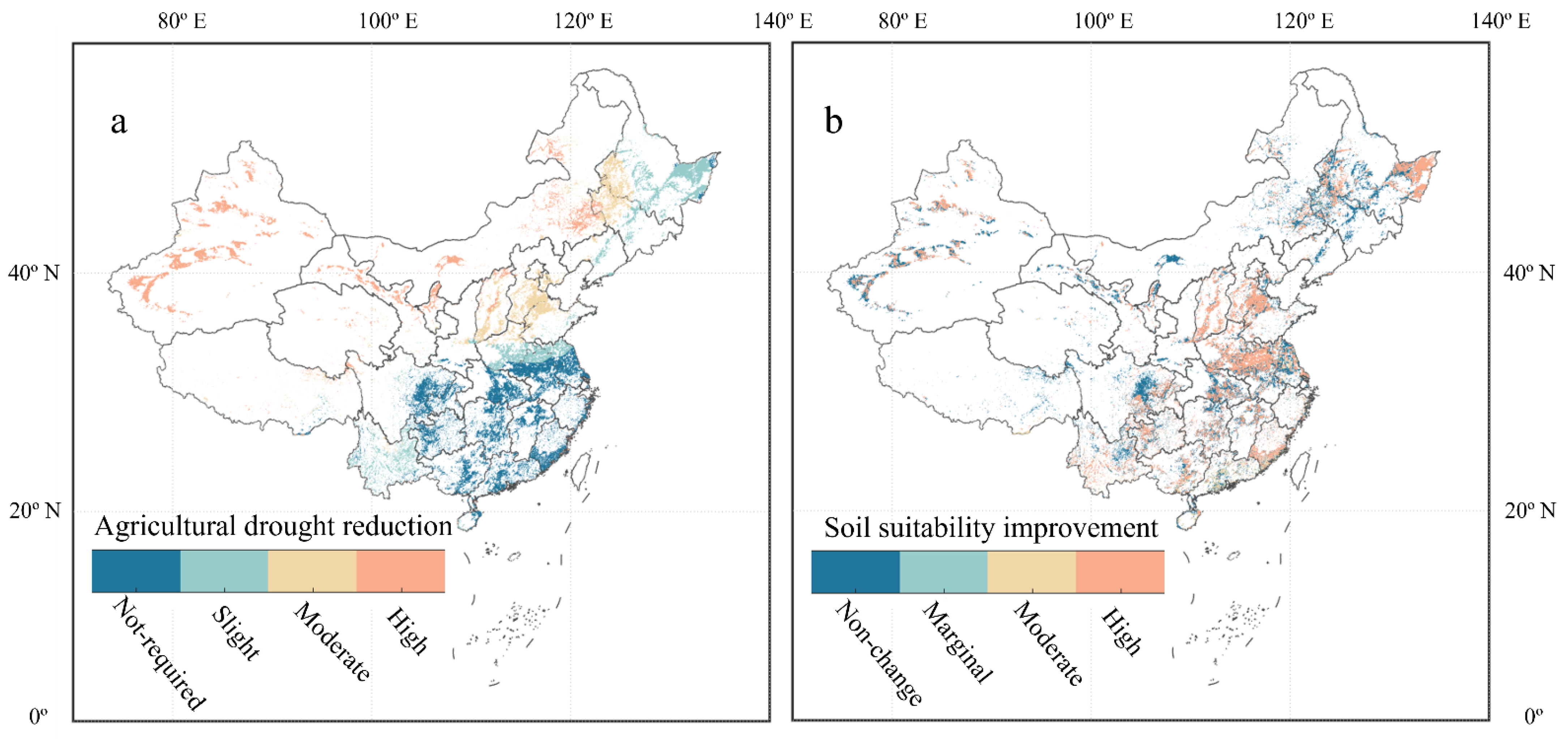
| No. | Type | Name | Spatial Resolution | Temporal Resolution | Applied Data |
|---|---|---|---|---|---|
| 1 | LULC | CCI_LC | 300 m, Global | Annual, 1992–2019 | (Irrigated) cropland |
| 2 | CLUD | 1 km, China | 5-year, 1980–2020 | Cropland | |
| 3 | HILDA+ | 1 km, Global | Annual, 1980–2019 | Cropland | |
| 4 | Existing irrigation maps | CIM | 1 km, China | Annual, 2000 | Irrigated cropland |
| 5 | GIA | 30 arcsec, Global | Annual, 2005 | Irrigated cropland | |
| 6 | GRIPC | 500 m, Global | Annual, 2005 | Irrigated cropland | |
| 7 | IAAA | 250 m, Asia | Annual, 2000 & 2010 | Irrigated cropland | |
| 8 | GFSAD | 1 km, Global | Annual, 2010 | Irrigated cropland | |
| 9 | Xiang2016 | 500 m, China | Annual, 2016 | Irrigated cropland | |
| 10 | GLC_FCS | 30 m, China | 5-year, 2015–2020 | Irrigated cropland | |
| 11 | Cropping system data | ACIA | 500 m, Asia | Annual, 2001–2019 | Actual CI |
| 12 | APRA | 500 m, Asia | Annual, 2000–2019 | Paddy rice | |
| 13 | ChinaCropArea 1 km | 1 km, China | Annual, 2000–2015 | Wheat | |
| 14 | GAEZ | 5 arcmin, global | Static, 1981–2010 | Potential rainfed CI |
| Year | A | B | C | D | E |
|---|---|---|---|---|---|
| 2000 | CCI-LC | Wheat | APRA | CIM | IAAA2000 |
| 2001 | CCI-LC | Wheat & ACIA | APRA | CIM | IAAA2000 |
| 2002 | CCI-LC | Wheat & ACIA | APRA | CIM | IAAA2000 |
| 2003 | CCI-LC | Wheat & ACIA | APRA | GRIPC | GMIA-m |
| 2004 | CCI-LC | Wheat & ACIA | APRA | GRIPC | GMIA-m |
| 2005 | CCI-LC | Wheat & ACIA | APRA | GRIPC | GMIA-m |
| 2006 | CCI-LC | Wheat & ACIA | APRA | GRIPC | GMIA-m |
| 2007 | CCI-LC | Wheat & ACIA | APRA | GRIPC | GMIA-m |
| 2008 | CCI-LC | Wheat & ACIA | APRA | GFSAD | IAAA2010 |
| 2009 | CCI-LC | Wheat & ACIA | APRA | GFSAD | IAAA2010 |
| 2010 | CCI-LC | Wheat & ACIA | APRA | GFSAD | IAAA2010 |
| 2011 | CCI-LC | Wheat & ACIA | APRA | GFSAD | IAAA2010 |
| 2012 | CCI-LC | Wheat & ACIA | APRA | GFSAD | IAAA2010 |
| 2013 | CCI-LC | Wheat & ACIA | APRA | Xiang 2016 | GLC_FCS2015 |
| 2014 | CCI-LC | Wheat & ACIA | APRA | Xiang 2016 | GLC_FCS2015 |
| 2015 | CCI-LC | Wheat & ACIA | APRA | Xiang 2016 | GLC_FCS2015 |
| 2016 | CCI-LC | ACIA | APRA | Xiang 2016 | GLC_FCS2015 |
| 2017 | CCI-LC | ACIA | APRA | Xiang 2016 | GLC_FCS2015 |
| 2018 | CCI-LC | ACIA | APRA | Xiang 2016 | GLC_FCS2020 |
| 2019 | CCI-LC | ACIA | APRA | Xiang 2016 | GLC_FCS2020 |
| Agreement Level | Score | A | B | C | D | E |
|---|---|---|---|---|---|---|
| 5 | 31 | 1 | 1 | 1 | 1 | 1 |
| 4 | 30 | 1 | 1 | 1 | 1 | 0 |
| 29 | 1 | 1 | 1 | 0 | 1 | |
| 28 | 1 | 1 | 0 | 1 | 1 | |
| 27 | 1 | 0 | 1 | 1 | 1 | |
| 26 | 0 | 1 | 1 | 1 | 1 | |
| 3 | 25 | 1 | 1 | 1 | 0 | 0 |
| 24 | 1 | 1 | 0 | 1 | 0 | |
| 23 | 1 | 0 | 1 | 1 | 0 | |
| 22 | 1 | 1 | 0 | 0 | 1 | |
| 21 | 1 | 0 | 1 | 0 | 1 | |
| 20 | 0 | 1 | 1 | 1 | 0 | |
| 19 | 0 | 1 | 1 | 0 | 1 | |
| 18 | 1 | 0 | 0 | 1 | 1 | |
| 17 | 0 | 1 | 0 | 1 | 1 | |
| 16 | 0 | 0 | 1 | 1 | 1 | |
| 2 | 15 | 1 | 1 | 0 | 0 | 0 |
| 14 | 1 | 0 | 1 | 0 | 0 | |
| 13 | 1 | 0 | 0 | 1 | 0 | |
| 12 | 0 | 1 | 1 | 0 | 0 | |
| 11 | 1 | 0 | 0 | 0 | 1 | |
| 10 | 0 | 1 | 0 | 1 | 0 | |
| 9 | 0 | 1 | 0 | 0 | 1 | |
| 8 | 0 | 0 | 1 | 1 | 0 | |
| 7 | 0 | 0 | 1 | 0 | 1 | |
| 6 | 0 | 0 | 0 | 1 | 1 | |
| 1 | 5 | 1 | 0 | 0 | 0 | 0 |
| 4 | 0 | 1 | 0 | 0 | 0 | |
| 3 | 0 | 0 | 1 | 0 | 0 | |
| 2 | 0 | 0 | 0 | 1 | 0 | |
| 1 | 0 | 0 | 0 | 0 | 1 | |
| 0 | 0 | 0 | 0 | 0 | 0 | 0 |
| Time-Series Dataset | Annual Dataset | |||||
|---|---|---|---|---|---|---|
| This Study | Irrimap-Syn | CCI-LC | Group D | Group E | ||
| 2000 | Correctly classified pixels | 405 | 423 | 395 | 390 | 321 |
| Overall accuracy | 65.96% | 68.89% | 64.33% | 63.52% | 52.28% | |
| Kappa coefficient | 0.28 | 0.34 | 0.26 | 0.23 | 0.11 | |
| 2005 | Correctly classified pixels | 433 | 415 | 401 | 416 | 404 |
| Overall accuracy | 70.52% | 67.59% | 65.31% | 67.75% | 65.80% | |
| Kappa coefficient | 0.37 | 0.31 | 0.28 | 0.34 | 0.24 | |
| 2010 | Correctly classified pixels | 423 | 413 | 410 | 386 | 315 |
| Overall accuracy | 68.89% | 67.26% | 66.78% | 62.87% | 51.30% | |
| Kappa coefficient | 0.34 | 0.3 | 0.31 | 0.19 | 0.08 | |
| 2015 | Correctly classified pixels | 425 | 424 | 407 | 384 | 298 |
| Overall accuracy | 69.22% | 69.06% | 66.29% | 62.54% | 48.53% | |
| Kappa coefficient | 0.34 | 0.34 | 0.3 | 0.19 | 0.08 | |
| Mean | Correctly classified pixels | 427 | 417 | 405 | \ | \ |
| Overall accuracy | 69.54% | 67.92% | 65.96% | |||
| Kappa coefficient | 0.35 | 0.32 | 0.29 | |||
| Total Area | Rain Land (%) | Pasture (%) | Woodland (%) | Built-Up (%) | Others (%) | ||||||||
|---|---|---|---|---|---|---|---|---|---|---|---|---|---|
| Gain | Loss | Gain | Loss | Gain | Loss | Gain | Loss | Gain | Loss | Gain | Loss | ||
| NIR | CNB | 4.19 | 1.54 | 60 | 74 | 16 | 21 | 0 | 0 | 1 | 4 | 23 | 1 |
| YERB | 1.44 | 0.65 | 70 | 60 | 18 | 27 | 0 | 3 | 9 | 10 | 2 | 0 | |
| Total | 5.63 | 2.19 | 62 | 70 | 17 | 23 | 0 | 1 | 3 | 6 | 18 | 1 | |
| NEP | \ | 6.19 | 0.79 | 85 | 71 | 12 | 23 | 1 | 1 | 2 | 6 | 1 | 0 |
| HHHP | HARB | 2.51 | 2.37 | 87 | 65 | 3 | 13 | 0 | 2 | 8 | 20 | 1 | 0 |
| YERB | 0.24 | 0.46 | 89 | 74 | 5 | 12 | 0 | 1 | 6 | 14 | 0 | 0 | |
| HURB | 5.93 | 3.06 | 92 | 87 | 2 | 2 | 0 | 0 | 5 | 11 | 0 | 0 | |
| Total | 8.68 | 5.90 | 91 | 77 | 3 | 7 | 0 | 1 | 6 | 15 | 0 | 0 | |
| YARB | \ | 7.81 | 5.12 | 64 | 50 | 21 | 21 | 5 | 8 | 9 | 20 | 1 | 1 |
| SCR | SEB | 0.51 | 0.34 | 15 | 14 | 17 | 11 | 44 | 25 | 21 | 49 | 2 | 2 |
| PRB | 2.24 | 1.26 | 30 | 26 | 35 | 32 | 16 | 22 | 18 | 20 | 1 | 1 | |
| SWB | 0.60 | 0.14 | 23 | 27 | 43 | 45 | 27 | 19 | 5 | 9 | 2 | 1 | |
| Total | 3.34 | 1.74 | 26 | 23 | 34 | 29 | 22 | 23 | 16 | 25 | 1 | 1 | |
Publisher’s Note: MDPI stays neutral with regard to jurisdictional claims in published maps and institutional affiliations. |
© 2022 by the authors. Licensee MDPI, Basel, Switzerland. This article is an open access article distributed under the terms and conditions of the Creative Commons Attribution (CC BY) license (https://creativecommons.org/licenses/by/4.0/).
Share and Cite
Bai, M.; Zhou, S.; Tang, T. A Reconstruction of Irrigated Cropland Extent in China from 2000 to 2019 Using the Synergy of Statistics and Satellite-Based Datasets. Land 2022, 11, 1686. https://doi.org/10.3390/land11101686
Bai M, Zhou S, Tang T. A Reconstruction of Irrigated Cropland Extent in China from 2000 to 2019 Using the Synergy of Statistics and Satellite-Based Datasets. Land. 2022; 11(10):1686. https://doi.org/10.3390/land11101686
Chicago/Turabian StyleBai, Minghao, Shenbei Zhou, and Ting Tang. 2022. "A Reconstruction of Irrigated Cropland Extent in China from 2000 to 2019 Using the Synergy of Statistics and Satellite-Based Datasets" Land 11, no. 10: 1686. https://doi.org/10.3390/land11101686
APA StyleBai, M., Zhou, S., & Tang, T. (2022). A Reconstruction of Irrigated Cropland Extent in China from 2000 to 2019 Using the Synergy of Statistics and Satellite-Based Datasets. Land, 11(10), 1686. https://doi.org/10.3390/land11101686






